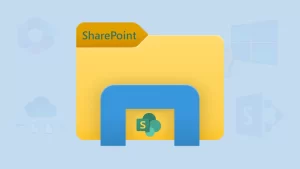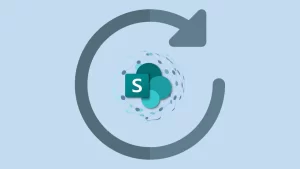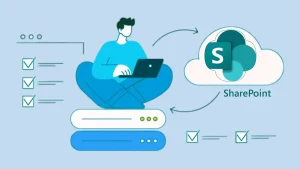Microsoft, a tech giant, has ruled the email niche since the very beginning; whether it is hosted email servers or cloud services, Microsoft is everywhere. From the Exchange server to Office 365, Microsoft has developed and launched a lot.
In 2011, Microsoft launched Office 365, and during the pandemic, Office 365 became very popular due to its anytime-anywhere accessibility; a must at that time, organizations picked Office 365 as their productivity suite.
Out of Office 365, there are several apps, and SharePoint is the most customizable and intelligent. In this write-up, we’ll dive into what SharePoint is, why we use SharePoint, and what are the benefits of SharePoint. So, let’s start.
What is SharePoint?
Microsoft SharePoint is a web-based application that allows users or organizations to share documents, business intelligence, advanced research, content collaboration and many more features.
SharePoint allows users to save time by storing files in the cloud and eliminating the need for multiple task and project management tools. With SharePoint, organizations can create an intranet to work with remote teams on a specific document.
Why Use SharePoint?
SharePoint is a safe haven for all sorts of files, including codes, visuals, graphics, audio files, documents, etc. Teams can work on these files from anywhere and anytime. Other SharePoint benefits include tools like data analytics, website templates, and project management workflows. Nowadays, every business professional also uses SharePoint in different stages.
SharePoint has several use cases, and the following are some of the most used SharePoint features.
- Files sharing within or outside the organizations.
- Manage content or files of different types, including images, articles, videos, and source code.
- Using SharePoint to create workflows and reminders to automate the project or tasks.
- Get in touch with a collaborator or creator.
Apart from these most used features, there are several other benefits of SharePoint.
Benefits of SharePoint Online:
- Improved accessibility: The first and possibly one of SharePoint’s top benefits is its accessibility. As stated above, SharePoint is a cloud-based service; hence, it can be accessed from anywhere and anytime. Whether you are on the beach or enjoying a sunset view in the mountains, if you need your SharePoint files, you can easily access them with just a few taps.
- Security and Privacy: Another SharePoint feature is its security. SharePoint is a Microsoft product, and we all know Microsoft is stringent regarding user security. SharePoint has built-in encryption technology that scrambles data as it travels between devices. Also, SharePoint allows users to enable multi-factor authentication to give an extra layer of data encryption. It makes it nearly impossible for hackers to alter or steal any information.
- Collaboration on projects: With SharePoint, your team can collaborate and work on a project effectively. SharePoint allows users to share files on a permission-based basis. Only the permission user can access the file to work on it, ensuring that only the authorized user has access to the file. Along with this, SharePoint offers a search feature that allows users to search for any particular file easily and instantly.
- Automation of everyday tasks: A collaboration platform like SharePoint is a perfect way to automate any task. Your team can easily automate common tasks like document management. Automation streamlines the work process, enhances the outcome effectively, and reduces manual labour without affecting work quality. This SharePoint benefit saves the organization a fortune by reducing the amount of time and labour needed.
- Customization: Another great benefit of SharePoint is its flexibility or, you can say, ease of customization. Organizations can use SharePoint to manage any inventory, project, task, or other tasks they are dealing with. This wide range of customization abilities makes it suitable for any business in any industry.
- Cost savings: After reading this much, I am confident I am saying SharePoint cost savings. The platform can reduce your cost in several factors, from manual labour to managing traditional on-site servers. Also, you don’t need any team to manage and update SharePoint as it is a cloud-based platform. Last but not least, organizations can skip paying a single penny for additional office space to set up a SharePoint server.
- Easy to use: Microsoft knows that providing this many features means nothing if the platform is not easy to use. SharePoint comes with a user-centric GUI, and even a novice can use the platform without any training. Also, Sharepoint provides everything your organization needs to boost productivity.
Want to Migrate to SharePoint?
After reading about all of SharePoint’s benefits, you might wonder how to migrate It. The answer is simple and recommended by several Microsoft MVPs: the Shoviv SharePoint Migration tool.
It is an automated tool that allows users to move data from different sites of SharePoint without any hassle. The tool is laced with several user-centric features that make the migration process a cakewalk. Even infants can migrate without any technical expertise or assistance.
“Related blog about SharePoint: SharePoint vs SharePoint Online: A Detailed Comparison“
Conclusion:
SharePoint is a must-have tool/utility for an organization to enhance their workflow and manage their documents. Nowadays, almost every second big organization uses SharePoint to manage its data and content. If you are one of those users who want to migrate into SharePoint from their current platform, then the Shoviv SharePoint Migration Tool is a one-stop solution for them. The tool offers several features and an easy-to-use GUI to migrate data into SharePoint. For a better evaluation, I suggest you use the free version of the Shoviv SharePoint Migration Tool. The demo allows you to process in less than 20KB without any restriction.
- How to Backup and Restore Emails in Webmail? - March 25, 2025
- How to Migrate Outlook to New Computer? - February 15, 2025
- Fix If Outlook Cannot Display the Specific Folder Location - February 1, 2025


